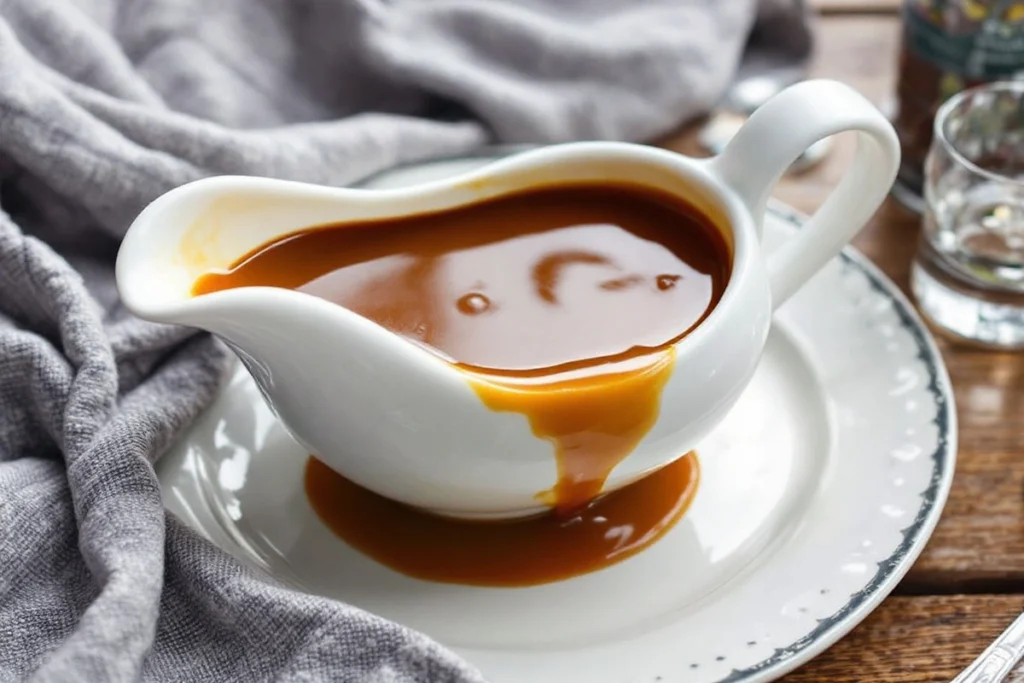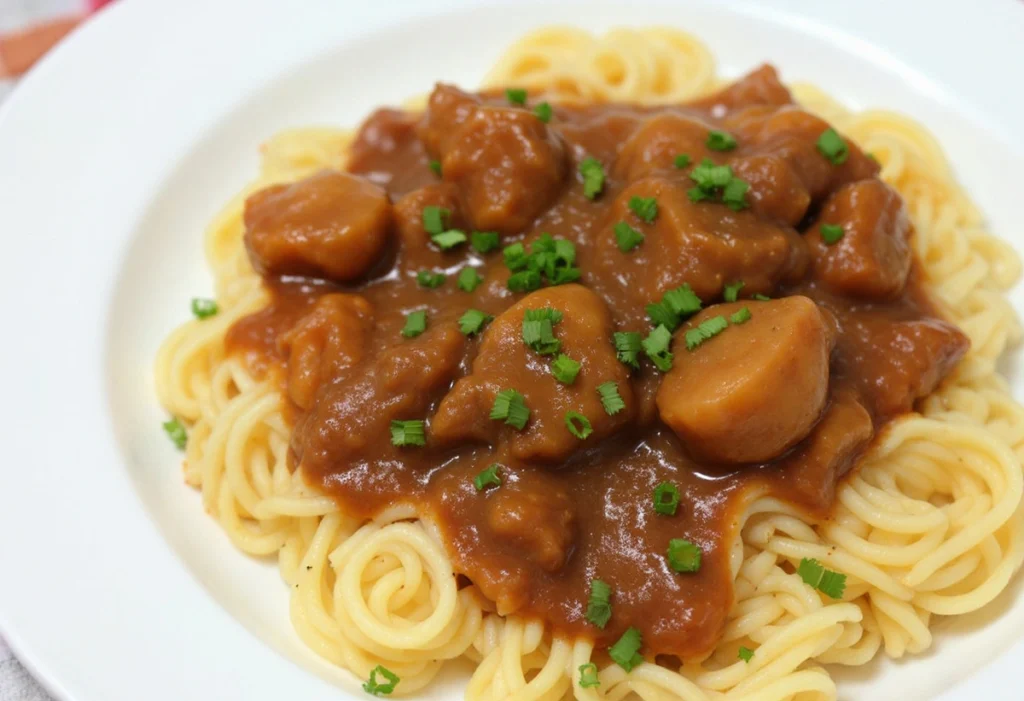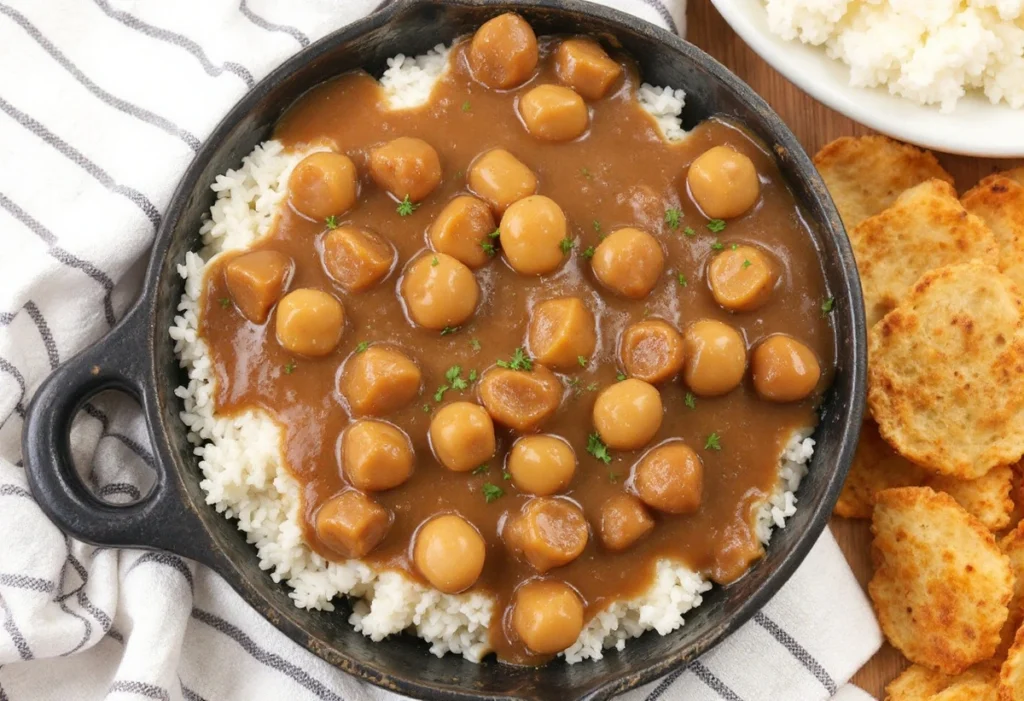
Introduction
Definition and Overview
Brown gravy is a rich, savory sauce made from a combination of fat, flour, and flavorful broth. It is often served as a topping for meats, mashed potatoes, and other comfort foods, enhancing their flavor with its velvety texture and hearty taste.
Its Origins and Popularity
The origins of brown gravy can be traced back to traditional European cuisine, where sauces were crafted to enhance the flavor of roasts and other dishes. Over time, it has become a staple in kitchens worldwide, cherished for its versatility and ability to elevate a simple meal into something special.
Why It’s a Staple in Comfort Foods
Brown gravy holds a special place in comfort food recipes:
- Flavorful Addition: Its savory taste pairs well with hearty dishes like pot roast, meatloaf, and turkey.
- Simple Ingredients: It’s made with pantry staples, making it easy to prepare at home.
- Warm and Inviting: The rich, warm flavor adds a comforting touch to meals.
Ingredients for Brown Gravy
Basic Ingredients: Butter, Flour, and Broth
- Butter: Provides the fat needed to create the roux, which thickens the gravy.
- Flour: Combines with the butter to form the roux, giving the gravy its silky texture.
- Broth: The main flavor component, made from beef, chicken, or vegetable stock.
Optional Add-Ins: Onion, Garlic, or Herbs
Enhance the flavor of your brown gravy with these optional ingredients:
- Onion: Sautéed onions add depth and sweetness to the gravy.
- Garlic: Minced garlic lends a rich, aromatic flavor.
- Herbs: Fresh or dried herbs like thyme, rosemary, or parsley give the gravy a touch of freshness and complexity.
Choosing the Right Broth: Beef, Chicken, or Vegetable
The type of broth you choose determines the flavor profile of your gravy:
- Beef Broth: Creates a hearty, robust flavor, perfect for roasts and steaks.
- Chicken Broth: Offers a lighter, more delicate taste, ideal for poultry dishes.
- Vegetable Broth: A great option for vegetarian or vegan meals, providing a mild, earthy flavor.
Equipment Needed
Saucepan or Skillet
- Saucepan: Ideal for making gravy with ample space for whisking and simmering.
- Skillet: A heavy-bottomed skillet works well, especially if you’re using pan drippings for added flavor.
Whisk for Lump-Free Gravy
- A sturdy whisk is essential for combining the roux and broth smoothly, ensuring a lump-free gravy.
Optional Tools for Straining and Serving
- Fine-Mesh Strainer: Strain the gravy to remove any lumps or solids for a silky texture.
- Gravy Boat or Ladle: Serve the gravy elegantly with a gravy boat or ladle for easy portioning.
Step-by-Step Recipe for Classic Brown Gravy
Making the Roux
- Melt Butter: Heat 2 tablespoons of butter in a saucepan or skillet over medium heat until melted.
- Add Flour: Sprinkle in 2 tablespoons of all-purpose flour and whisk continuously.
- Cook the Roux: Continue whisking and cooking for 2–3 minutes, or until the roux turns golden brown and develops a nutty aroma. This step builds the base flavor of the gravy.
Adding the Broth and Seasonings
- Gradually Add Broth:
- Slowly pour in 2 cups of your chosen broth (beef, chicken, or vegetable), whisking constantly to prevent lumps.
- Add the broth in small amounts at first, ensuring it incorporates smoothly before adding more.
- Season:
- Add salt, pepper, and any optional seasonings such as garlic powder, onion powder, or fresh herbs.
- For richer flavor, stir in a splash of Worcestershire sauce or soy sauce.
Achieving the Perfect Consistency
- Simmer and Thicken:
- Bring the mixture to a gentle simmer, whisking frequently. The gravy will thicken as it cooks, usually within 5–7 minutes.
- Adjust Consistency:
- If the gravy is too thick, whisk in a small amount of broth or water until desired consistency is reached.
- If it’s too thin, continue simmering until it thickens, or whisk in a slurry made of equal parts water and flour.
- Strain (Optional):
- For an ultra-smooth texture, strain the gravy through a fine-mesh strainer before serving.
Classic brown gravy is a versatile sauce that can elevate any meal. Whether served over mashed potatoes, roast beef, or vegetables, its rich, savory flavor and smooth consistency make it a favorite addition to comfort foods.

Variations of Brown Gravy
Onion Brown Gravy
- Flavor Profile: Sautéed onions add a natural sweetness and depth of flavor to classic brown gravy.
- How to Make: Cook thinly sliced onions in butter until caramelized, then proceed with the roux and broth.
- Best Pairings: Perfect for steak, pork chops, or as a topping for meatloaf.
Mushroom Brown Gravy
- Flavor Profile: Mushrooms introduce an earthy richness, making this a hearty option.
- How to Make: Sauté sliced mushrooms in butter before adding flour for the roux, then follow the usual steps.
- Best Pairings: Excellent with chicken, mashed potatoes, or over egg noodles for a stroganoff-inspired dish.
Gluten-Free or Vegan Brown Gravy
- Gluten-Free: Replace flour with cornstarch or a gluten-free flour blend. Use gluten-free broth to ensure safety for those with dietary restrictions.
- Vegan: Use vegetable broth, plant-based butter, and a non-dairy milk or cream substitute for added richness.
- Best Pairings: Serve over roasted vegetables, vegan meatloaf, or rice for a plant-based comfort meal.
Pairing Brown Gravy with Dishes
Meat Pairings: Roast Beef, Turkey, or Pork Chops
Brown gravy complements a variety of meats:
- Roast Beef: Drizzle over sliced roast beef for a classic pairing.
- Turkey: Use brown gravy as an alternative to traditional turkey gravy for a richer flavor.
- Pork Chops: The savory, umami notes of brown gravy enhance the juiciness of pork chops.
Classic Side Dishes: Mashed Potatoes or Rice
Brown gravy adds a comforting, flavorful touch to these sides:
- Mashed Potatoes: A must-have combination for any comfort food meal.
- Rice: Pour over steamed or seasoned rice for a simple yet satisfying accompaniment.
Creative Uses in Casseroles and Pies
- Shepherd’s Pie: Use brown gravy as the base for the meat filling.
- Casseroles: Incorporate into beef or chicken casseroles for added moisture and flavor.
- Pot Pies: Enhance homemade pot pies by using brown gravy as part of the sauce.
Tips for Perfect Brown Gravy
Preventing Lumps with Proper Whisking
- Gradual Liquid Addition: Add broth to the roux slowly, whisking constantly to prevent clumps.
- Strain If Needed: Use a fine-mesh strainer to remove any lumps for a smooth finish.
Balancing Flavors with Salt, Pepper, and Herbs
- Season Gradually: Add salt and pepper in small increments, tasting as you go to avoid over-seasoning.
- Enhance with Herbs: Use thyme, rosemary, or parsley for a more complex flavor profile.
Adjusting Thickness with Flour or Stock
- Thicker Gravy: Whisk in a slurry of equal parts flour (or cornstarch) and water, cooking until thickened.
- Thinner Gravy: Add more broth or water, whisking to blend, until desired consistency is reached.
Brown gravy is a versatile, flavorful addition to countless dishes, whether as a simple topping or a key ingredient in casseroles and pies. With these variations, pairings, and tips, you can create the perfect gravy to elevate any meal!
Frequently Asked Questions (FAQs)
How Long Can Brown Gravy Be Stored?
- Refrigeration: Brown gravy can be stored in the refrigerator for 3–4 days in an airtight container.
- Freezing: For longer storage, freeze the gravy for up to 3 months. Ensure it’s completely cooled before freezing to maintain its texture.
Can I Use Cornstarch Instead of Flour?
Yes, cornstarch can be used as a substitute for flour:
- How to Use: Mix cornstarch with cold water (1 tablespoon cornstarch to 2 tablespoons water) to make a slurry. Add it to the hot broth and stir until thickened.
- Difference: Cornstarch creates a clearer, glossy gravy compared to the creamier texture achieved with flour.
What’s the Best Broth to Use?
The best broth depends on your dish and flavor preferences:
- Beef Broth: Offers a robust, hearty flavor ideal for roasts and steaks.
- Chicken Broth: A lighter option, great for poultry dishes.
- Vegetable Broth: Perfect for vegetarian or vegan meals, with an earthy and mild taste. For richer flavor, use homemade broth or stock whenever possible.
How Do I Fix Lumpy Gravy?
- Whisk Vigorously: Use a whisk to break up lumps as the gravy cooks.
- Strain: Pour the gravy through a fine-mesh strainer to remove lumps for a smooth consistency.
- Blend: Use an immersion blender to quickly smooth out the texture.
Is Brown Gravy Gluten-Free?
Traditional brown gravy made with all-purpose flour is not gluten-free. To make it gluten-free:
- Flour Substitute: Use cornstarch, arrowroot powder, or a gluten-free flour blend.
- Broth: Ensure the broth is gluten-free, as some brands may contain gluten.
How Can I Add Depth of Flavor?
Enhance the flavor of your brown gravy with these tips:
- Aromatics: Sauté onions or garlic in butter before making the roux.
- Worcestershire or Soy Sauce: Add a splash for umami richness.
- Herbs and Spices: Incorporate thyme, rosemary, or a bay leaf during cooking.
- Wine or Sherry: Deglaze the pan with a small amount of wine or sherry for a sophisticated depth of flavor.
Brown gravy is a timeless classic that elevates any dish with its rich, savory flavor and velvety texture. Made with simple ingredients like butter, flour, and broth, it pairs perfectly with roasted meats, mashed potatoes, and casseroles. Whether you’re preparing a traditional Sunday roast or experimenting with international flavors, brown gravy is a versatile and essential addition to any meal. For more comforting recipes and hearty meal ideas, explore content like Tater Tot Breakfast Casserole or Rocky Road Fudge Recipe for a delightful dessert to complement your meal.
Homemade Brown Gravy vs. Store-Bought
Comparing Flavor and Freshness
- Homemade: Offers a rich, fresh taste with customizable seasoning and texture. Using fresh ingredients like butter, broth, and herbs ensures superior flavor.
- Store-Bought: Pre-made gravies or powdered mixes are convenient but often lack the depth of flavor found in homemade versions. They may also contain preservatives and artificial flavors.
Convenience vs. Control Over Ingredients
- Homemade: Allows complete control over ingredients, making it easier to adjust for dietary needs (e.g., gluten-free, low-sodium) or personal taste preferences.
- Store-Bought: Wins on convenience, ideal for quick meals or when time is limited. However, you may sacrifice some nutritional quality or taste.
When to Use Store-Bought Options
- Busy Schedules: Store-bought gravy is a lifesaver for last-minute dinners.
- Large Gatherings: When cooking multiple dishes, store-bought gravy can save preparation time.
- Enhancing Dishes: Use it as a base and elevate the flavor by adding fresh herbs, spices, or sautéed vegetables.

Brown Gravy Around the World
Regional Variations in Recipes
Brown gravy recipes differ across regions, reflecting local culinary traditions:
- United States: Often paired with mashed potatoes, roast beef, or turkey, and sometimes made with pan drippings for added richness.
- United Kingdom: Known as “gravy,” it’s typically served with Sunday roasts and made using meat juices and stock.
- France: A variation called sauce brune incorporates wine or cognac for a more refined flavor.
How Different Cuisines Use Brown Gravy
- Scandinavian Cuisine: Brown gravy is a key component of dishes like Swedish meatballs, served with lingonberry sauce for a sweet-savory contrast.
- Asian Cuisine: While not traditionally “brown gravy,” similar sauces like soy-based gravies are used in stir-fries or over rice.
- German Cuisine: Often includes beer or mustard in the gravy to accompany schnitzels or sausages.
Why It’s Universally Loved
- Versatility: Brown gravy complements a wide range of dishes, from meats and vegetables to casseroles and pies.
- Comfort Factor: Its warm, rich flavor makes it a staple in comfort food worldwide.
- Simplicity: With basic ingredients and easy preparation, brown gravy remains accessible to home cooks everywhere.
Conclusion
Recap of Its Versatility and Simplicity
Brown gravy is a timeless and versatile sauce that enhances a wide variety of dishes, from meats and potatoes to casseroles and pies. Its rich flavor, simple ingredients, and easy preparation make it a staple in kitchens around the world. Whether you prefer a classic recipe or enjoy experimenting with variations like onion or mushroom gravy, its adaptability ensures there’s a version to suit every palate.
Encouragement to Try Homemade Brown Gravy
If you haven’t yet made your own brown gravy from scratch, now is the perfect time to try. Homemade gravy offers unparalleled freshness, depth of flavor, and the ability to customize ingredients to meet your taste and dietary preferences. With just a few pantry staples, you can create a rich, velvety sauce that outshines any store-bought alternative.
Final Thoughts on Its Role in Comfort Cooking
Brown gravy holds a special place in comfort cooking, transforming simple meals into indulgent experiences. Its warm, savory notes evoke nostalgia and bring a sense of satisfaction to the table. Whether served at a family dinner or holiday feast, brown gravy is more than just a sauce—it’s a comforting tradition that brings people together over delicious food.
Viral Tuna Salad: 5 Bold Reasons Matthew McConaughey’s Recipe Wins
Healthy Homemade Chicken Mortadella
Chicken Mortadella changed my deli game forever. I used to stare at processed meat…
The BEST Taco Pasta
When I’m short on time and need to get a satisfying dinner on…
Classic German Kartoffelpuffer Recipe (Authentic, Crispy & Easy to Make)
Easy Butter Pecan Cookies Recipe
There’s something undeniably comforting about the scent of buttery, nutty cookies wafting from…
Perfect Strawberry Cheesecake Recipe
If there’s one dessert that’s guaranteed to silence a lively room, it’s this…






